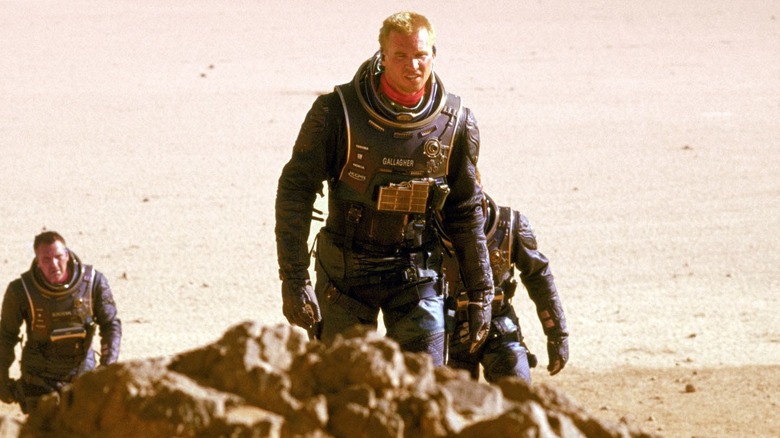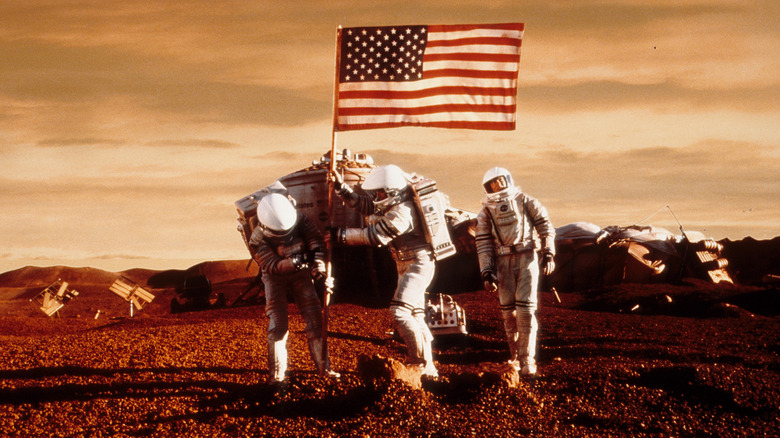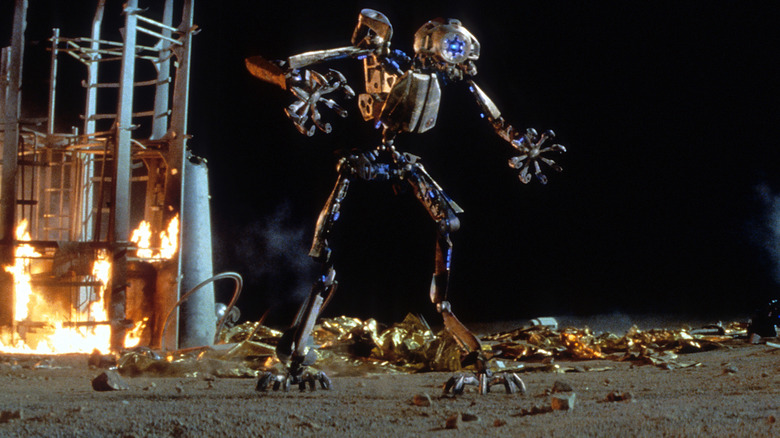25 Years Ago, Mars Was Responsible For Two Big Sci-Fi Box Office Bombs
As the calendar turned from 1999 to 2000 and the new millennium dawned, we as a society developed a bit of an obsession with Mars. That obsession resulted in several large-scale movies about the fourth planet from the Sun. Two of those movies arrived in theaters exactly eight months apart from one another in the year 2000. Both of them bombed spectacularly.
Today, November 10, marks the 25th anniversary of the theatrical debut of the second of those films, director Antony Hoffman's ill-fated and aptly-named "Red Planet." Starring Val Kilmer ("Batman Forever") and Tom Sizemore ("Saving Private Ryan"), it was an $80 million budgeted gambit spearheaded by Warner Bros. that flamed out at the box office, becoming one of the most high-profile flops that year. "Mission to Mars" was neck-and-neck with it in this bizarre example of the twin movie phenomenon.
"Red Planet" takes place in the mid-21st century as the Earth is dying, leaving the world's people to look to the stars for a solution. They set out to colonize Mars. But something no one could have expected awaits a doomed mission, as Mars may be barren, but it's not uninhabited. Yep! There are deadly aliens.
Both "Red Planet" and "Mission to Mars" were capitalizing on the Mars obsession. Granted, sci-fi had a long history with Mars, but as talk of climate change began to heat up in the mainstream throughout the '90s, the notion of humanity needing to colonize another planet became more realistic than it had ever been. CGI and advances in visual effects technology were also helpful. VFX on this scale can also be very expensive, which ultimately doomed both of these movies.
Mission to Mars flopped first - but Red Planet flopped harder
Brian De Palma, who was coming off the Nic Cage-starring misfire "Snake Eyes," directed "Mission to Mars." The film takes place in 2020 and picks up after the first manned mission to Mars meets sufferers a mysterious, catastrophic disaster, reporting an unidentified structure. A rescue mission is sent to investigate the tragedy and bring back any survivors. Surprise! They encounter aliens, too.
Handled by Buena Vista Pictures, a now-defunct label that was dropped by Disney in 2007, the film boasted a star-studded cast that included Gary Sinise ("Forrest Gump"), Don Cheadle ("Boogie Nights"), and Connie Nielsen ("The Devil's Advocate"), among others. It was also tragically expensive, with a reported $100 million budget at a time when that was still pretty rare. For context, that would be like having a $188 million budget in today's Hollywood.
Unfortunately, it would be hard to call it money well spent. The movie arrived in theaters on March 10, 2000, earning lousy reviews. (It still holds a 23% approval rating on Rotten Tomatoes to this day.) And while it topped the box office on opening weekend with $22.8 million, its fall from grace was swift, and it wasn't nearly enough to save it from eventual flop status.
The film finished its run with just $60.8 million domestically to go with $50.1 million internationally for a grand total of $110.9 million worldwide. It's not as bad as, say, "The Adventures of Pluto Nash" making just $7.1 million on a $100 million budget, but few things are.
Even though the bar was set very low, "Red Planet" failed to clear that bar, somehow becoming the bigger flop of the two. It boasted an $80 million budget, roughly $150 million in today's dollars. Again, that spelled doom.
Mission to Mars and Red Planet were doomed for several reasons
Hoffman's Mars flick hit theaters exactly eight months later on November 10, 2000. It opened to just $8.7 million, coming in at fifth on the charts behind the likes of "Charlie's Angels" and another big bomb in the form of Adam Sandler's "Little Nicky." It got worse from there, with the film falling out of the top 10 entirely by Thanksgiving.
"Red Planet" finished its run with $17.4 million domestically to go with $15.9 million internationally for a ruinous total of just $33.4 million worldwide, barely cracking the top 100 globally for the year overall. It ultimately finished just behind another flop in the form of 2000's "Dungeons & Dragons." In terms of return on investment, both of these movies were trainwrecks, but this film was worse off.
So, what went wrong? In both cases, critics were not on their side. "Red Planet" has a dreadful 14% on Rotten Tomatoes. That's never a good place to start. Hollywood may've also greatly overestimated the public's interest in Mars movies. Still, it's bizarre to have both sides of a dual film phenomenon fail so spectacularly. "Armageddon" had to duke it out with "Deep Impact," but "Armageddon" made $553 million and was the biggest movie of 1998.
These movies just got too big for their own good. It's not that expensive movies about Mars can't work. Ridley Scott's "The Martian" made well over $600 million in 2015, but critics and audiences alike enjoyed the final product. It's easier said than done, but if any Hollywood studio is going to spend such an outlandish amount of money, it would do well to maximize quality control (much in the same way that NASA had best do its diligence if it's going to send people to space, lest it wish to court catastrophe).


